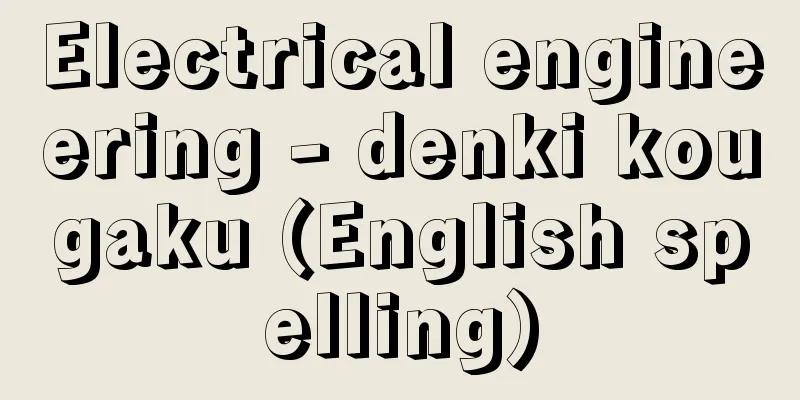Electrical engineering - denki kougaku (English spelling)

|
It is a field of engineering that deals with the research and application of electrical and magnetic phenomena, and electromagnetic waves (light). When broadly divided into fields related to electricity as a medium for transmitting information and electricity as a medium for transmitting energy, the former is sometimes called weak electricity and the latter strong electricity. In the narrow sense, electrical engineering means power engineering (the field of engineering that handles electricity as energy). Humans have been interested in electrical and magnetic phenomena since ancient times, dating back to the pre-Christian era. However, these were mostly just imagination. In 1600, Gilbert published "De Magnete", and for about two centuries after that, there were discoveries and experiments such as the friction generator, Leyden jar, lightning rod, and animal electricity. However, none of them captured the essence of electrical and magnetic phenomena, and did not establish the foundation of electrical engineering. Since Coulomb established the basic experimental laws regarding static electricity in 1785, systematic research into electromagnetism has progressed, with Oersted's discovery of the magnetic effect of electric current (1819-1820), Ampere's discovery of the electromotive force law (1820), Ohm's discovery of the experimental laws regarding electrical resistance (1826), Faraday's discovery of the phenomenon of electromagnetic induction (1831), and Kirchhoff's establishment of the basic theory of circuit networks (1848). In 1864, Maxwell presented a concise set of equations that describe all electrical and magnetic phenomena, and on the basis of these equations the existence of electromagnetic waves was theoretically derived. In 1888, Hertz demonstrated the existence of electromagnetic waves, completing the theory of phenomena that forms the basis of electrical engineering. From the 1880s to the 1950s, important events such as Steinmetz's AC theory (1893), Planck's quantum theory (1900), Einstein's special theory of relativity (1905), Shannon's information theory (1948), Slater's ferromagnetism theory (1951), Bardeen et al.'s establishment of the theory of superconductivity (1957), J. J. Thomson's discovery of the electron (1897), K. Jansky's (1905-1950) discovery of cosmic radio waves (1931), and Hahn and Strassmann's discovery of the nuclear fission phenomenon of uranium (1938) occurred one after another. Based on these discoveries and theories, electrical engineering was born, and has since branched out into communication technology, power technology, electronics technology, information processing and control technology, and biomedical engineering. Today, electrical engineering covers a wide range of subjects, and while each field is a specialized field, the fields are closely related to each other, making it difficult to clearly distinguish between them. Since the beginning of the 21st century, the role of electrical engineering has become increasingly important, with important issues such as further improvements in computer performance, further developments in technology that applies computers to networks of wireless and wired communication, the efficient use of energy as seen in the example of extending the battery life of mobile devices, and the development of energy sources that reduce carbon dioxide emissions to prevent global warming, such as solar panels and wind power, as well as storage technologies that reduce fluctuations in generated power. [Madashi Fuse and Masazumi Yoshizawa] Communication TechnologyIn 1809, German scientist Semmering focused on the bubbles that are generated when water is electrolyzed, and devised a method of transmitting signals by preparing a large number of electrolytic cells. This is considered to be the prototype of wired telegraphy. With the invention of Morse code in 1837, wired telegraphy became a practical means of communication, and for the next 40 years or so, wired telegraphy became the mainstream of electrical technology. With the invention of the telephone by Bell in 1876, wired communication technology developed further. The reason why the application of electricity began with wired communication technology is that in the early days, batteries were the only power source, and using electrical energy was not very practical, so electricity was used in the field of communication, which did not require a large amount of power. When the existence of electromagnetic waves was demonstrated in 1888, wireless telegraphy was invented, utilizing electromagnetic waves generated by electrical discharge. In 1898, Marconi began commercial wireless telegraphy services. Later, in 1906, the American de Forest invented the triode vacuum tube, which made it possible to amplify and oscillate alternating current from low to high frequencies, and to use high frequencies with little noise. This led to a dramatic advancement in wired and wireless communication technology. In the field of wired communication, the unloaded cable method proposed by Matsumae Shigeyoshi was realized by using a vacuum tube amplifier. In the field of wireless communication, the use of vacuum tubes led to a diversification of applications, expanding the range of applications to include broadcasting, radar, and television. The wavelengths of the radio waves used also gradually became shorter, and even the microwave range was put into practical use during World War II. Since the successful generation of lasers in 1960, various kinds of lasers have appeared, and currently, optical communication methods using semiconductor lasers and low-loss optical fibers have been put to practical use (1977), and the wavelengths of electromagnetic waves used for communication have expanded into the optical range. Meanwhile, with the realization of artificial satellites, the active communication satellite "Telstar" was successfully tested in 1962, and wireless communication has spread into space. The development of these wired and wireless communication technologies, combined with the development of information processing and control technologies, has made possible not only human-to-human communication, but also human-to-machine and machine-to-machine communication. [Madashi Fuse and Masazumi Yoshizawa] Power TechnologyIn 1799, Volta invented the electric pile, which made it possible to obtain direct current for the first time. In 1800, British scientists Nicholson and Anthony Carlisle (1768-1840) succeeded in electrolyzing water using this. In 1802, Davy successfully experimented with an arc lamp using pieces of charcoal. These were early applications of electricity to do work, but they were limited to the laboratory. Various improvements were made to batteries after that, making them more practical, but batteries had weaknesses in capacity, durability, and handling, and could not be used as an effective power source. As a result, technology to utilize electrical energy did not develop during this period. Later, in 1867, E. W. Siemens invented the self-excited direct current generator, which made it possible to obtain a large amount of direct current stably. Around this time, the incandescent light bulb was invented by Edison (1879) and the electric railway was invented by Siemens (1879), opening the way for the use of electrical energy. Thus, electric power technology started with the use of direct current, but in 1891, the three-phase alternating current (AC) transmission system proposed by the German Dolibo Dobrovolsky was found to be superior to the DC transmission system, and AC began to be put to practical use. This enabled the efficient transportation of large amounts of electricity, and electric power technology played a central role in electrical engineering. For the next half century (a period when communication and electronic technologies were developing rapidly and extensively), no significant new technology emerged in the field of electric power technology, but the success of nuclear power generation at the Argonne National Laboratory in the United States in 1951 opened a new phase in electric power technology. Today, nuclear power generation plays an important role in addition to conventional hydroelectric and thermal power generation. However, in light of the accidents at several nuclear power plants, the question of whether to continue nuclear power generation is the subject of global debate. [Madashi Fuse and Masazumi Yoshizawa] ElectronicsThe discovery of the electron by Thomson in 1897 was an important event that laid the foundation for modern electronics. The triode vacuum tube, created by De Forest in 1906, was the first ingenious device that utilized electrons. Over the next half century, devices utilizing free electrons appeared one after another, including the magnetron (1921), cathode ray tube oscillograph (1927), iconoscope (1933), electron microscope (1933), klystron (1939), traveling wave tube (1944), and others. The term "electronics" also appeared during this period. The invention of the transistor by Shockley, Bardeen, and Brattain in 1948 brought about a major change in electronics, which had previously been centered on vacuum tubes. It not only replaced vacuum tubes with semiconductors, but also paved the way for the ultra-miniaturization of electronic circuits. Since the first integrated circuit (IC) was created by Texas Instruments in the United States in 1959, the degree of integration has increased year by year, leading to the appearance of large-scale integrated circuits (LSI) in 1966 and very large-scale integrated circuits (VLSI) in 1978. Integrated circuits have revolutionized electronic technology because they are small, lightweight, reliable, and inexpensive, and electronic devices are now incorporated into almost all industrial products, from artificial satellites to electric rice cookers. Today, electronic circuits and computers are incorporated into everyday products, such as smartphones, and they are required to perform to withstand advanced use. To meet this demand, electronic technology is playing an increasingly important role, with the development of low-power microprocessors and increased processing speeds, programmable logic circuits, and practical application of new types of electronic circuits. [Madashi Fuse and Masazumi Yoshizawa] Quantum ElectronicsIn 1960, American Theodore Harold Maiman (1927-2007) succeeded in emitting a laser using ruby. This used stimulated emission, which differs from conventional devices that use free electrons, and gave birth to the field known as quantum electronics. After this, various lasers using solids, liquids, and gases were realized, making it possible to obtain laser light from infrared to ultraviolet, opening up new applications that were not possible with natural light, such as communication technology, measurement technology, processing technology, medicine, nuclear fusion, and art. [Madashi Fuse and Masazumi Yoshizawa] Information processing and control technologyThe idea of automatic control has been around for a long time, as can be seen in the governors of steam engines, but in the field of electrical engineering it began to develop after American Harry Nyquist (1889-1976) discussed the stability of feedback amplifiers in 1932. Automatic control methods were initially mainly analog, but with the advancement of digital circuits, there was a gradual shift to digital methods. In particular, automatic control technology using computers led to the realization of robots. Since the creation of an industrial robot by the American company Consolidated Control in 1958, a large number of robots have been operating in production factories. Computers also have a long history. In 1642, Pascal invented a mechanical calculator, but the first automatic calculator was the MARK-I, created by American Howard Hathaway Aiken (1900-1973) in 1944. There is also a theory that the first automatic calculator was the Z3, completed by German Konrad Zuse (1910-1995) around 1941. The following year, in 1945, von Neumann proposed the stored program computer. In 1949, the first stored program computer, the EDSAC, was created by British Maurice Vincent Wilkes (1913-2010), and is still in use today. Semiconductor devices, which appeared around this time, were immediately incorporated into computers. In 1959, the IBM 1401, a fully transistorized computer, was completed. The use of semiconductors significantly improved the reliability of computers, and computers entered the era of practical use. Advances in semiconductor technology also gave birth to integrated circuits, which enabled the creation of high-speed large-scale computers. Meanwhile, in 1969, the microprocessor using LSI was invented, and in 1971, the microcomputer, commonly known as the personal computer, appeared using the microprocessor. Computers have become smaller over time, leading to the appearance of laptops and notebooks, which are computers that can be placed on one's lap, and smartphones, which are computers equipped with mobile phone functions. On the one hand, the advancement of computers has enabled large-scale information processing, realizing diagnostic equipment that would be impossible without computers, such as computed tomography (CT) devices, and has also helped to improve functions through image processing, etc. In addition, supercomputers with extremely high calculation speeds using cutting-edge technology are used in the design and simulation of weather forecasts, automobiles, ships, aircraft, high-rise buildings, nuclear power, etc., and have helped to realize more accurate forecasts, safer and more fuel-efficient automobiles, ships, aircraft, and high-rise buildings that are resistant to earthquakes. In addition, they are being actively used in the fields of biology and chemistry, such as molecular design and genetic analysis, and are playing a large role in the advancement of medicine and the development of new materials. On the other hand, they provide small-scale information processing on an individual basis, such as personal computers and smartphones, and even enable systems in which ultra-small computers are built into various devices and, in some cases, connected by a network to work together. For example, efforts are being made to build a traffic system that is free of traffic accidents and congestion by connecting automobiles to a network, and such applications are spreading. [Madashi Fuse and Masazumi Yoshizawa] Biomedical EngineeringMedical electronics (ME), proposed by Zworkin, is a branch of electrical engineering that emerged after the Second World War, but it has expanded to biomedical engineering (BME) and continues to grow as an interdisciplinary cutting-edge technology. It includes various fields such as bioinstrumentation, which is the basis of disease diagnosis technology, bioinformation processing, biofunctions, which are the basis of technology that substitutes for the functions of the living body, artificial living organs, biological phenomena and biological properties to elucidate the mechanisms of the living body, medical systems for treatment, and ergonomics to improve safety. Electrical engineering is indispensable in all of these fields. While the current approach of BME is centered on the application of engineering and technology to living bodies, there is also research on the development of information processing technology modeled on the functions of living bodies and the use of living bodies as functional elements. [Madashi Fuse and Masazumi Yoshizawa] "The History of Electricity" by Hideo Seki (1977, Japan Broadcasting Association)" ▽ "The Pioneers of Electronics" by Nobuhiko Mizushima (1985, Institute of Electronics and Communication Engineers)" ▽ "The History of Electricity - A Story of People and Technology" by Yuzo Takahashi (2011, Tokyo Denki University Press) [References] | | | | | | | | waves| | | | | |Source: Shogakukan Encyclopedia Nipponica About Encyclopedia Nipponica Information | Legend |
|
電気・磁気現象、電磁波(光)の研究や応用を取り扱う工学の一分野をいう。情報を伝達する媒体としての電気に関する分野、エネルギー伝送媒体としての電気に関する分野に大きく分ける場合は、前者を弱電、後者を強電とよぶ場合もある。狭義の電気工学は電力工学(電気をエネルギーとして扱うための工学分野)を意味する。人間が電気・磁気現象に関心を抱いたのは古く、紀元前にさかのぼる。しかし、それらはおおかた想像の域を出るものではなかった。1600年ギルバートによって『磁石について』が発表され、その後約2世紀の間、摩擦起電器、ライデン瓶、避雷針、動物電気などの発見・実験があった。しかし、いずれも電気・磁気現象の本質をとらえておらず、電気工学の基礎を築くには至らなかった。1785年クーロンによって静電気に関する基本的な実験法則が確立されて以来、エールステッドによる電流の磁気作用の発見(1819~1820)、アンペールによる電流力の法則の発見(1820)、オームによる電気抵抗に関する実験法則の発見(1826)、ファラデーによる電磁誘導現象の発見(1831)、キルヒホッフによる回路網の基礎理論の確立(1848)など、電磁気学の系統的な研究が進んだ。1864年マクスウェルによって電気・磁気現象のいっさいを表す方程式が簡潔な形で提出され、これに基づいて電磁波の存在が理論的に導き出された。1888年ヘルツによって電磁波の存在が実証され、ここに電気工学の基礎をなす現象理論が完成した。その後、スタインメッツによる交流理論(1893)、プランクによる量子論(1900)、アインシュタインによる特殊相対性理論(1905)、シャノンによる情報理論(1948)、スレーターによる強磁性理論(1951)、バーディーンらによる超伝導理論の確立(1957)、またJ・J・トムソンによる電子の発見(1897)、ジャンスキーK. Jansky(1905―1950)による宇宙電波の発見(1931)、ハーン、シュトラスマンによるウランの核分裂現象の発見(1938)などの重要なできごとが、1880年代から1950年代にかけて相次いでみられた。これらの発見および理論を基礎にして電気工学が生まれ、通信技術、電力技術、電子技術、情報処理・制御技術、医用生体工学などに枝分れして発展した。現在では、電気工学の対象はきわめて多岐にわたっており、それぞれが専門分野を形成している一方、各分野は互いに密接に関連しており、各専門分野をはっきりと区別することが困難になっている。 21世紀に入ってからの電気工学は、コンピュータのさらなる性能向上、コンピュータと無線・有線通信によるネットワークを応用した技術のさらなる発展と、携帯機器の電池駆動時間の延長の例にみられるようなエネルギーの効率的な利用、ソーラーパネルや風力発電のように地球温暖化防止のため二酸化炭素の排出を抑えたエネルギー発生源とその発電電力の変動を抑える蓄電技術の発展、などが重要な課題となり、ますます役割が大きくなっている。 [布施 正・吉澤昌純] 通信技術1809年、ドイツのゼンメリンクは水を電気分解するとき発生する気泡に着目し、多数の電解槽を用意して信号を伝える方法を考案した。これが有線電信の原形と考えられる。1837年モールス符号が考案されて有線電信は実用的な通信手段となり、その後の約40年間は有線電信が電気技術の中心となった。1876年ベルによって電話が発明されて有線通信技術はさらに発展した。このように電気の応用が有線通信技術から始まったのは、初期においては電池が唯一の電源であったため、電気のエネルギーを利用することは実用性に乏しく、大きな電力を必要としない通信の分野で電気が利用されたためであった。 1888年電磁波の存在が実証されると、放電によって生ずる電磁波を利用した無線電信が考案された。1898年にはマルコーニによって商業無線電信業務が開始された。その後、1906年にアメリカのド・フォレストによって三極真空管が発明されて、低周波から高周波にわたって交流の増幅、発振が可能になり、雑音の少ない高周波が利用できるようになった。これにより、有線・無線通信技術は飛躍的に進歩した。有線通信の分野では、松前重義(しげよし)の提案した無装荷ケーブル方式が、真空管増幅器を利用することにより実現した。無線通信の分野では、真空管の活用によって応用が多様化し、放送、レーダー、テレビジョンと応用分野が広がっていった。また、利用する電波の波長もしだいに短くなってゆき、第二次世界大戦中にはマイクロ波領域まで実用化された。1960年レーザーの発振に成功して以来、各種のレーザーが出現したが、現在では半導体レーザーと、低損失光ファイバーを利用した光通信方式が実用化(1977)され、通信に利用する電磁波の波長は光領域にまで及んだ。一方、人工衛星の実現によって、1962年には能動通信衛星「テルスター」の実験に成功し、無線通信は宇宙にまで広がった。 これら有線・無線通信技術の発達は情報処理・制御技術の発達と相まって、人対人だけでなく、人対機械、機械対機械の対話を可能にした。 [布施 正・吉澤昌純] 電力技術1799年、ボルタによって電気堆(たい)が発明され、初めて直流電流が得られるようになった。1800年、イギリスのニコルソンとカーライルAnthony Carlisle(1768―1840)はこれを使って水の電気分解に成功した。1802年にはデービーが木炭片を使ってアーク灯の実験に成功した。これらが電気を使って仕事をさせた初期の応用であるが、その規模は実験室の域を出なかった。その後電池の改良が種々行われ、実用性が高まったが、電池は容量、耐久性、取扱いの点に弱点があり、有効な電源とはなりえなかった。そのため、この時代は電気のエネルギーを利用する技術は発達しなかった。その後、1867年、E・W・ジーメンスによって自励式直流発電機が発明され、多量の直流が安定して得られるようになった。またこのころ、エジソンによる白熱電灯の発明(1879)、ジーメンスによる電気鉄道の考案(1879)などがあって、電気エネルギーの利用の道が開かれた。このように電力技術は直流の利用から始まったが、ドイツのドリボ・ドブロボルスキーによって提案された三相交流送電方式は、1891年に行われた実験で、その直流送電方式に対する優位が認められ、交流の実用化が始まった。これによって大量の電力の輸送が効率よく行われるようになり、電力技術が電気工学の中心的役割を担うこととなった。その後の半世紀の間(この時期は通信技術および電子技術が急速かつ広範囲に発展したときであったが)、電力技術の分野では飛躍的な新技術は現れなかったが、1951年アメリカ、アルゴンヌ国立研究所における原子力発電の成功は、電力技術に新局面を開いた。現在では、在来の水力発電、火力発電に加えて、原子力発電が重要な役割を果たすようになっている。しかし、いくつかの原子力発電所の事故を踏まえ、原子力発電をこのまま行うかは世界的な議論の対象となっている。 [布施 正・吉澤昌純] 電子技術1897年トムソンによる電子の発見は、現在のエレクトロニクスの礎(いしずえ)を築く重要なできごとであった。1906年ド・フォレストによってつくられた三極真空管は、電子を利用した最初の巧妙なデバイス(からくり)であった。それからの半世紀の間に、マグネトロン(1921)、ブラウン管オシログラフ(1927)、アイコノスコープ(1933)、電子顕微鏡(1933)、クライストロン(1939)、進行波管(1944)その他自由電子を利用したデバイス(装置)が次々と出現した。エレクトロニクスという語もこの時期に現れた。1948年、ショックレー、バーディーン、ブラッテンによるトランジスタの発明は、それまでの真空管を中心としたエレクトロニクスに大きな変化をもたらした。それは単に、真空管を半導体に置き換えただけでなく、電子回路の超小型化の端緒を開いた。1959年にアメリカ、テキサス・インスツルメンツ社によって最初の集積回路(IC)がつくられて以来、年を追って集積度が高まり、1966年には大規模集積回路(LSI)が、1978年には超大規模集積回路(VLSI)が出現した。集積回路は小型・軽量で信頼性が高く、かつ安価であることから電子技術に革命的変化をもたらし、人工衛星から電気炊飯器に至るまで、ほとんどすべての工業製品に電子装置が組み込まれるようになった。現在ではスマートフォンにみられるように、身の回りの製品に電子回路やコンピュータが組み込まれ、高度な使用に耐えられる性能が求められている。これにこたえるため、マイクロプロセッサーの低消費電力化と処理速度の向上や、プログラムにより変更できる論理回路、新しいタイプの電子回路の実用化など、電子技術はますます重要な役割を担う分野となっている。 [布施 正・吉澤昌純] 量子エレクトロニクス1960年、アメリカのメイマンTheodore Harold Maiman(1927―2007)はルビーを用いてレーザーの発振に成功した。これは、従来の自由電子を利用するデバイスとは異なる誘導放出を利用するもので、量子エレクトロニクスとよばれる分野が誕生した。このあと、固体、液体、気体を用いた各種のレーザーが実現し、赤外線から紫外線にわたってレーザー光が得られるようになり、通信技術、計測技術、加工技術、医学、核融合、芸術などに自然光ではなしえなかった新しい応用面を開いた。 [布施 正・吉澤昌純] 情報処理・制御技術自動制御の考えは、蒸気機関のガバナー(調速機)にみられるように古くからあったが、電気工学の分野では、1932年アメリカのナイキストHarry Nyquist(1889―1976)によって帰還増幅器の安定性が論じられてから発達し始めた。自動制御の方法も、当初はアナログ方式が主であったが、デジタル回路の進歩に伴い、しだいにデジタル方式に移行していった。とくにコンピュータを利用した自動制御技術はロボットの実現をもたらした。1958年アメリカのコンソリデイテッド・コントロール社によって産業用ロボットがつくられて以来、多数のロボットが生産工場で稼動するようになった。 コンピュータの歴史も古く、1642年にはパスカルによって機械式計算機が考案されたが、自動式計算機は1944年アメリカのエイケンHoward Hathaway Aiken(1900―1973)によってつくられたMARK‐Ⅰ(マークワン)が最初とされている。1941年ごろドイツのツーゼKonrad Zuse(1910―1995)が完成させたZ3(ゼットスリー)が最初という説もある。翌1945年にはノイマンによって蓄積プログラム方式のコンピュータが提案された。1949年、イギリスのウィルクスMaurice Vincent Wilkes(1913―2010)によって最初のプログラム内蔵方式のコンピュータEDSAC(エドサック)がつくられ、現在に至っている。このころ出現した半導体デバイスはただちにコンピュータに取り入れられた。1959年には、全トランジスタ化したコンピュータIBM1401が完成した。半導体を使用することによってコンピュータの信頼性が著しく向上し、コンピュータは実用化の時代に入った。また、半導体技術の進歩は集積回路を生み出し、これを利用することによって高速大型コンピュータが実現した。一方、1969年にはLSIを利用したマイクロプロセッサーが考案され、1971年にはマイクロプロセッサーを使ってマイクロコンピュータ、いわゆるパーソナルコンピュータ(パソコン)が出現した。その大きさは時代につれ小型化され、膝(ひざ)の上にのせられるコンピュータという意味のラップトップ型、ノート型、そして、コンピュータに携帯電話機能をもたせたスマートフォンの出現に至っている。 このようにコンピュータの進歩は、一方で大規模な情報処理を可能にし、たとえばコンピュータ断層撮影computed tomography(CT)装置のように、コンピュータなしでは不可能な診断装置を実現させており、さらに画像処理等による機能の高度化にも役だっている。また、最先端の技術による演算速度がきわめて高速なスーパーコンピュータは、気象予報、自動車、船舶、航空機、高層ビル、原子力などにおいて設計やシミュレーションに使われ、これまでより精度の高い予報、安全性が高くより燃費のよい自動車、船舶、航空機、地震に強い高層ビル等の実現に役だっている。さらに、分子設計や遺伝子解析などバイオ、化学分野での活用も盛んであり、医療の高度化や新素材開発に果たす役割が大きくなっている。他方では、パソコンやスマートフォンのように小規模の情報処理を個人単位に提供し、さらには超小型のコンピュータをいろいろな機器に組み込み、場合によってはそれらをネットワークにより接続し、互いに協調作業を行うシステムをも可能としている。たとえば、自動車のネットワーク接続による交通事故がなく渋滞しない交通システムの構築が取り組まれており、このような応用が広がりつつある。 [布施 正・吉澤昌純] 医用生体工学ツウォリキンによって提唱された医用電子工学(ME)は、第二次世界大戦後に誕生した電気工学の一分野であるが、現在では医用生体工学(BME)に拡張され、学際的な先端技術として成長を続けている。これには病気の診断技術の基礎となる生体計測、生体情報処理、生体の機能を代行する技術の基礎となる生体作用、人工生体器官、生体のメカニズムを解明するための生体現象、生体物性、治療のための医用システム、安全性を高めるための人間工学などの諸分野を含んでいる。これらすべての分野で、電気工学がなくてはならないものとなっている。現在のBMEは、工学・技術を生体に適用する方向の考え方が中心をなしているのに対し、生体の機能を手本にした情報処理技術の開発や、生体を機能素子として利用する研究も行われている。 [布施 正・吉澤昌純] 『関英男著『電気の歴史』(1977・日本放送出版協会)』▽『水島宣彦著『エレクトロニクスの開拓者たち』(1985・電子通信学会)』▽『高橋雄造著『電気の歴史――人と技術のものがたり』(2011・東京電機大学出版局)』 [参照項目] | | | | | | | | | | | | | |出典 小学館 日本大百科全書(ニッポニカ)日本大百科全書(ニッポニカ)について 情報 | 凡例 |
<<: Legendary works - Electric works
Recommend
Family: Red whale stinger - Red whale stinger
…A general term for marine fishes belonging to th...
Taoryu Hills - Yurugi Hills
A hill in the south-central part of Kanagawa Prefe...
Powder compact
Sintering is a process where the powder particles...
folktale
…The same can be said for folk tales and fairy ta...
Paper making studio
…It had one administrative officer with the ranks...
Alcaldia Mayor (English spelling) Alcaldiamayor
… The administrative divisions of the Viceroyalty...
Solāpur (English spelling)
...Industrial city in the southern tip of Maharas...
Vasubandhu
...Indian Buddhist scholar from around the 5th ce...
Ukekaji - Blacksmith
…There are records that something similar was don...
Hǔnamni‐yujŏk (English spelling)
Located in Heunam-ri, Jeongdong-myeon, Yeoju-gun, ...
Acharanata - Acharanata
…It is a Chinese translation of the Sanskrit name...
Large book - Ogatahon
…(2) A book larger than the Minohon. Also called ...
Rubbing - Takuhon
This refers to the technique of transferring char...
Itsuji Shrine - Itsuji no Miya
This is an Imperial family from the end of the Kam...
Meteor - Ryusei (English spelling)
A shooting star is a light that appears suddenly ...









